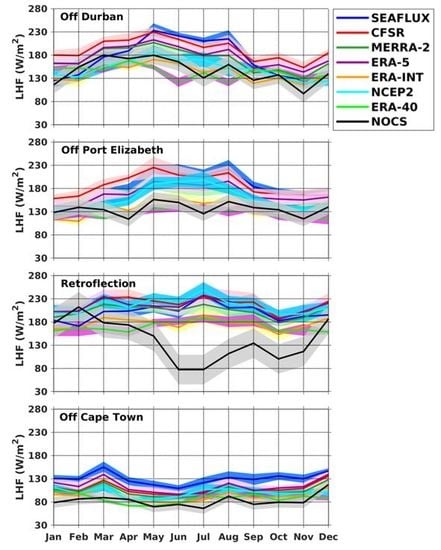Latent Heat Flux in the Agulhas Current
Abstract
1. Introduction
2. Data and Methods
2.1. In-Situ Observations
2.2. Satellite Remote Sensing
2.3. Reanalyses
2.4. Methods
3. Results
3.1. Seasonal Mean and Annual Cycle of Latent Heat Flux
3.2. Differences of Latent Heat Flux between SEAFLUX and Other Products
3.3. Seasonal Mean and Annual Cycle of Sea Surface Temperature
3.4. Seasonal Mean and Annual Cycle of Surface Wind Speed
3.5. Seasonal Mean and Annual Cycle of Specific Humidity
3.5.1. Surface Specific Humidity (Qss)
3.5.2. Specific Humidity of Air (Qa)
3.5.3. Differences between Surface and Air Specific Humidity (Qss-Qa)
4. Drivers of the Annual Cycle of Latent Heat Flux using SEAFLUX
5. Discussion and Conclusions
Supplementary Materials
Author Contributions
Funding
Acknowledgments
Conflicts of Interest
References
- Beal, L.M.; Elipot, S.; Houk, A.; Leber, G.M. Capturing the transport variability of a western boundary jet: Results from the Agulhas Current Time-Series Experiment (ACT). J. Phys. Oceanogr. 2015, 45, 1302–1324. [Google Scholar] [CrossRef]
- Lutjeharms, J.R.E.; Van Ballegooyen, R.C. The Retroflection of the Agulhas Current. J. Phys. Oceanogr. 1988, 18, 1570–1583. [Google Scholar] [CrossRef]
- Lutjeharms, J.R.E.; Mey, R.D.; Hunter, I.T. Cloud lines over the Agulhas Current. S. Afr. J. Sci. 1986, 82, 635–640. [Google Scholar]
- Rouault, M.; Lee-Thorp, A.M.; Ansorge, I.; Lutjeharms, J.R.E. The Agulhas Current Air–sea Exchange Experiment. S. Afr. J. Sci. 1995, 91, 493–496. [Google Scholar]
- Rouault, M.; Lee-Thorp, A.M.; Ansorge, I.; Lutjeharms, J.R.E. Observations of the atmospheric boundary layer above the Agulhas Current during along current winds. J. Phys. Oceanogr. 2000, 30, 70–85. [Google Scholar] [CrossRef]
- Jury, M.R.; Pathack, B.; Rautenbach, C.D.W.; Vanheerden, J. Drought over South Africa and Indian Ocean SST: statistical and GCM results. Global Atmos. Ocean Syst. 1996, 4, 47–63. [Google Scholar]
- Nkwinkwa Njouodo, A.S.N.; Koseki, S.; Keenlyside, N.; Rouault, M. Atmospheric Signature of the Agulhas Current. Geophys. Res. Lett. 2018, 45, 5185–5193. [Google Scholar] [CrossRef]
- O’Neill, L.W.; Chelton, D.B.; Esbensen, S.K.; Wentz, F.J. High-Resolution Satellite Measurements of the Atmospheric Boundary Layer Response to SST Variations along the Agulhas Return Current. J. Clim. 2005, 18, 2706–2723. [Google Scholar] [CrossRef]
- Rouault, M.; Verley, P.; Backeberg, B. Wind changes above warm Agulhas Current eddies. Ocean Sci. 2016, 12, 495–506. [Google Scholar] [CrossRef]
- Krug, M.; Schilperoort, D.; Collard, F.; Hansen, M.W.; Rouault, M. Signature of the Agulhas Current in ASAR derived wind fields. Remote Sens. Environ. 2018, 217, 340–351. [Google Scholar] [CrossRef]
- Chelton, D.B.; Schlax, M.G.; Freilich, M.H.; Milliff, R.F. Satellite Measurements Reveal Persistent Small-Scale Features in Ocean Winds. Sci. 2004, 303, 978–983. [Google Scholar] [CrossRef] [PubMed]
- Mey, R.D.; Walker, N.D.; Jury, M.R. Surface heat fluxes and marine boundary layer modification in the Agulhas Retroflection region. J. Geophys. Res. Space Phys. 1990, 95, 15997–16015. [Google Scholar] [CrossRef]
- Lee-Thorp, A.M.; Rouault, M.; Lutjeharms, J.R.E. Moisture up- take in the boundary layer above the Agulhas Current: A case study. J. Geophys. Res. 1999, 104, 1423–1430. [Google Scholar] [CrossRef]
- Rouault, M.; Lee-Thorp, A.M. Fine-time resolution measurements of atmospheric boundary layer properties between Cape Town and Marion Island. S. Afr. Mar. Sci. 1997, 17, 281–296. [Google Scholar] [CrossRef][Green Version]
- Rouault, M.; Lutjeharms, J.R.E. Air–sea exchanges over an Agulhas eddy at the subtropical convergence. Global Atmos. Ocean Syst. 2000, 7, 125–150. [Google Scholar]
- Rouault, M.; Reason, C.J.C.; Lutjeharms, R.E.; Beljaars, A. NCEP Reanalysis and ECMWF operational model underestimation of latent and sensible heat fluxes above the Agulhas Current. J. Clim. 2003, 16, 776–782. [Google Scholar] [CrossRef]
- Lutjeharms, J.R.E.; Rouault, M. Observations of cloud formation above Agulhas Current intrusions in the South-east Atlantic. S. Afr. J. Sci. 2000, 96, 577–580. [Google Scholar]
- Rouault, M.; White, S.A.; Reason, C.J.C.; Lutjeharms, J.R.E.; Jobard, I. Ocean–Atmosphere Interaction in the Agulhas Current Region and a South African Extreme Weather Event. Weather. Forecast. 2002, 17, 655–669. [Google Scholar] [CrossRef]
- Rouault, M.; Penven, P.; Pohl, B. Warming in the Agulhas Current system since the 1980’s. Geophys. Res. Lett. 2009, 36, L12602. [Google Scholar] [CrossRef]
- Gimeno, L.; Drumond, A.; Nieto, R.; Trigo, R.M.; Stohl, A. On the origin of continental precipitation. Geophys. Res. Lett. 2010, 37. [Google Scholar] [CrossRef]
- Uppala, S.M.; Kallberg, P.W.; Simmons, A.J.; Andrae, U.; Da Costa Bechtold, V.; Fiorino, M.; Gibson, J.K.; Haseler, J.; Hernandez, A.; Kelly, G. A.; et al. The ERA-40 re-analysis. Q. J. R. Meteorol. Soc. 2005, 131, 2961–3012. [Google Scholar] [CrossRef]
- Kalnay, E.; Kanamitsu, M.; Kistler, R.; Collins, W.; Deaven, D.; Gandin, L.; Iredell, M.; Saha, S.; White, G.; Woollen, J.; et al. The NCEP/NCAR 40-year reanalysis project. Bull. Am. Meteorol. Soc. 1996, 77, 437–471. [Google Scholar] [CrossRef]
- Kanamitsu, M.; Ebisuzaki, W.; Woollen, J.; Yang, S.-K.; Hnilo, J.J.; Fiorino, M.; Potterl, G.L. NCEP–DOE AMIP-II Reanalysis (R-2). Bull. Amer. Meteor. Soc. 2002, 83, 1631–1643. [Google Scholar] [CrossRef]
- Saha, S.; Moorthi, S.; Pan, H.L.; Wu, X.; Wang, J.; Nadiga, S.; Tripp, P.; Kistler, R.; Woollen, J.; Behringer, D.; et al. The NCEP climate forecast system reanalysis. Bull. Am. Meteorol. Soc. 2010, 91, 1015–1057. [Google Scholar] [CrossRef]
- Curry, J.A.; Bentamy, A.; Bourassa, M.A.; Bourras, D.; Bradley, E.F.; Brunke, M.; Castro, S.; Chou, S.H.; Clayson, C.A.; Emery, W.J.; et al. SEAFLUX. Bull. Amer. Meteor. Soc. 2004, 85, 409–424. [Google Scholar] [CrossRef]
- Woodruff, S.D.; Slutz, R.J.; Jenne, R.L.; Steurer, P.M. A comprehensive ocean-atmosphere dataset. Bull. Am. Meteorol. Soc. 1987, 68, 1239–1250. [Google Scholar] [CrossRef]
- Berry, D.I.; Kent, E.C. A new air–sea interaction gridded dataset from ICOADS with uncertainty estimates. Bull. Am. Meteorol. Soc. 2009, 90, 645–656. [Google Scholar] [CrossRef]
- Berry, D.I.; Kent, E.C. Air–sea fluxes from ICOADS: the construction of a new gridded dataset with uncertainty estimates. Intern. J. Climatol. 2011, 31, 987–1001. [Google Scholar] [CrossRef]
- Reynolds, R.W.; Smith, T.M. Improved global sea surface temperature analyses using optimum interpolation. J. Clim. 1994, 7, 929–948. [Google Scholar] [CrossRef]
- Lornec, A.C. A global three-dimensional multivariate statistical interpolation scheme. Mon. Weather. Rev. 1981, 109, 701–721. [Google Scholar] [CrossRef]
- Thomas, B.R.; Kent, E.C.; Swail, V.R.; Berry, D.I. Trends in ship wind speeds adjusted for observation method and height. Intern. J. Climatol. 2008, 28, 747–763. [Google Scholar] [CrossRef]
- Smith, S.D. Wind stress and heat flux over the ocean in gale force winds. J. Phys. Oceanogr. 1980, 10, 709–726. [Google Scholar] [CrossRef]
- Smith, S.D. Coefficients for sea surface wind stress, heat flux, and wind profiles as a function of wind speed and temperature. J. Geophys. Res. 1988, 93, 15467–15472. [Google Scholar] [CrossRef]
- Kent, E.C.; Kaplan, A. Towards estimating climatic trends in SST. Part III: systematic biases. J. Atmos. Oceanic Technol. 2006, 23, 487–500. [Google Scholar] [CrossRef]
- Josey, S.A.; Kent, E.C.; Taylor, P.K. New insights into the ocean heat budget closure problem and analysis of the SOC air–sea flux climatology. J. Clim. 1999, 12, 2856–2880. [Google Scholar] [CrossRef]
- Clayson, C.A.; Roberts, J.B.; Bogdanoff, A. SEAFLUX Version 1: a new satellitebased ocean-atmosphere turbulent flux dataset. Int. J. Climatol. 2013. submitted. [Google Scholar]
- Andersson, A.; Fennig, K.; Klepp, C.; Bakan, S.; Graßl, H.; Schulz, J. The Hamburg Ocean Atmosphere Parameters and Fluxes from Satellite Data HOAPS-3. Earth Syst. Sci. 2010, 2, 215–234. [Google Scholar]
- Andersson, A.; Fennig, K.; Klepp, C.; Bakan, S.; Graßl, H.; Schulz, J. Evaluation of HOAPS-3 ocean surface freshwater flux components. J. Appl. Meteorol. Climatol. 2011, 50, 379–398. [Google Scholar] [CrossRef]
- Casey, K.S. Global AVHRR 4 km SST for 1985-2001; Pathfinder V5.0, NODC/RSMAS, Technical Report; NOAA National Oceanographic Data Center: Silver Spring, MD, USA, 2004. [Google Scholar]
- Murray, F.W. On the Computation of Saturation Vapor Pressure. J. Appl. Meteor. 1967, 6, 203–204. [Google Scholar] [CrossRef]
- Bentamy, A.; Katsaros, K.B.; Mestas-Nunez, A.M.; Drennan, W.M.; Forde, E.B.; Roquet, H. Satellite Estimates ofWind Speed and Latent Heat Flux Over the Global Oceans. J. Clim. 2003, 16, 637–656. [Google Scholar] [CrossRef]
- Fairall, C.W.; Bradley, E.F.; Hare, J.E.; Grachev, A.A.; Edson, J.B. Bulk parameterization of air–sea fluxes: updates and verification for the COARE algorithm. J. Clim. 2003, 16, 571–591. [Google Scholar] [CrossRef]
- Chou, S.H.; Nelkin, E.; Ardizzone, J.; Atlas, J.R. A comparison of latent heat fluxes over global oceans for four flux products. J. Clim. 2004, 17, 3973–3989. [Google Scholar] [CrossRef]
- Smith, S.R.; Hughes, P.J.; Bourassa, M.A. A comparison of nine monthly air–sea flux products. International J. Climatol. 2011, 31, 1002–1027. [Google Scholar] [CrossRef]
- Bentamy, A.; Piolle, J.-F.; Grouazel, A.; Danielson, R.; Gulev, S.; Frederic, P.; Hamza, A.; Mathieu, P.P.; Von Schuckmann, K.; Sathyendranath, S.; et al. Review and assessment of latent and sensible heat flux accuracy over the global oceans. Remote Sens. Environ. 2017, 201, 196–218. [Google Scholar] [CrossRef]
- Reynolds, R.W.; Smith, T.M.; Liu, C.; Chelton, D.B.; Casey, K.S.; Schlax, M.G. Daily high-resolution-blended analyses for sea surface temperature. J. Clim. 2007, 20, 5473–5496. [Google Scholar] [CrossRef]
- Roberts, J.B.; Clayson, C.A.; Robertson, F.R.; Jackson, D.L. Predicting near-surface atmospheric variables from Special Sensor Microwave/Imager using neural networks with a first-guess approach. J. Geophys. Res. Atmos. 2010, 115. [Google Scholar] [CrossRef]
- Kilpatrick, K.A.; Podestá, G.; Walsh, S.; Williams, E.; Halliwell, V.; Szczodrak, M.; Brown, O.B.; Minnett, P.J.; Evans, R. A decade of sea surface temperature from MODIS. Remote Sens. Environ. 2015, 165, 27–41. [Google Scholar] [CrossRef]
- Chan, P.-K.; Gao, B.-C. A comparison of MODIS, NCEP, and TMI sea surface temperature datasets. IEEE Geosci. Remote Sens. Lett. 2005, 2, 270–274. [Google Scholar] [CrossRef]
- Rio, M.-H.; Mulet, S.; Picot, N. Beyond GOCE for the ocean circulation estimate: Synergetic use of altimetry, gravimetry, and in situ data provides new insight into geostrophic and Ekman currents. Geophys. Res. Lett. 2014, 41. [Google Scholar] [CrossRef]
- Johannessen, J.A.; Chapron, B.; Collard, F.; Rio, M.H.; Piollé, J.F.; Quartly, G.; Shutler, J.; Escola, R.; Donlon, C.; Danielson, R.; et al. GlobCurrent: Sentinel-3 Synergy in action. In Proceedings of the Sentinel-3 for Science Workshop, Venice, Italy, 2–5 June 2015. [Google Scholar]
- Hart-Davis, M.; Backeberg, B.C.; Halo, I.E.; Van Sebille, E.; Johannessen, J.A. Assessing the accuracy of satellite derived ocean currents by comparing observed and virtual buoys in the great Agulhas region. Remote Sens. Environ. 2018, 216, 735–746. [Google Scholar] [CrossRef]
- Risien, C.M.; Chelton, D.B. A Global Climatology of Surface Wind and Wind Stress Fields from Eight Years of QuikSCAT Scatterometer Data. J. Phys. Oceanogr. 2008, 38, 2379–2413. [Google Scholar] [CrossRef]
- Milliff, R.F.; Morzel, J. The global distribution of the time-average wind-stress curl from NSCAT. J. Atmos. Sci. 2001, 58, 109–131. [Google Scholar] [CrossRef]
- Bosilovich, M.G.; Lucchesi, R.; Suarez, M. MERRA-2: File Specification. GMAO Office Note No. 9 (Version 1.1); p. 73. Available online: http://gmao.gsfc.nasa.gov/pubs/office_notes (accessed on 8 December 2017).
- Hersbach, H.; Dee, D. ERA5 reanalysis is in production. Available online: https://www.ecmwf.int/en/elibrary/16299-newsletter-no-147-spring-2016 (accessed on 24 May 2019).
- Dee, D.P.; Uppala, S.M.; Simmons, A.J.; Berrisford, P.; Poli, P.; Kobayashi, S.; Andrae, U.; Balmaseda, M.A.; Balsamo, G.; Bauer, P.; et al. The ERA-Interim reanalysis: Configuration and performance of the data assimilation system. Q. J. Royal Meteorol. Soc. 2011, 137, 553–597. [Google Scholar] [CrossRef]
- Griffies, S.M.; Harrison, M.J.; Pacanowski, R.C.; Rosati, A. Technical Guide to MOM4; GFDL Ocean Group Technical Report; NOAA/Geophysical Fluid Dynamics Laboratory: Princeton, NJ, USA, 2004. [Google Scholar]
- Rienecker and Coauthors. MERRA - NASA’s Modern-Era Retrospective Analysis for Research and Applications. J. Clim. 2011, 24, 3624–3648. [Google Scholar] [CrossRef]
- Taylor, K.E.; Williamson, D.; Zwiers, F. The sea surface temperature and sea-ice concentration boundary conditions for AMIP II simulations; PCMDI Technical Report; Lawrence Livermore National Laboratory, University of California: Livermore, CA, USA, 2000; p. 28. [Google Scholar]
- Donlon, C.J.; Martin, M.; Stark, J.; Roberts-Jones, J.; Fiedler, E.; Wimmer, W. The Operational Sea Surface Temperature and Sea Ice Analysis (OSTIA) system. Remote Sens. Environ. 2012, 116, 140–158. [Google Scholar] [CrossRef]
- Holm, E.V. Revision of the ECMWF humidity analysis: Construction of a Gaussian control variable. In Proceedings of the ECMWF/GEWEX Workshop on Humidity Analysis, Reading, UK, 8–11 July 2002. [Google Scholar]
- Bourassa, M.A.; Vincent, D.G.; Wood, W.L. A flux parameterization including the effects of capillary waves and sea state. J. Atmos. Sci. 1999, 56, 1123–1139. [Google Scholar] [CrossRef]
- Bolton, D. Computation of equivalent potential temperature. Mon. Weather. Rev. 1980, 108, 1046–1053. [Google Scholar] [CrossRef]
- Buck, A.L. New equations for computing vapor pressure and enhancement factor. J. Appl. Meteorol. 1981, 20, 1527–1532. [Google Scholar] [CrossRef]
- Brunke, M.A.; Fairall, C.W.; Zeng, X.; Eymard, L.; Curry, J.A. Which bulk aerodynamic algorithms are least problematic in computing ocean surface turbulent fluxes? J. Clim. 2003, 16, 619–635. [Google Scholar] [CrossRef]
- Singh, R.; Joshi, P.C.; Kishtawal, C.M. A new technique for estimation of surface latent heat fluxes using satellites-based observations. Mon. Weather Rev. 2005, 133, 2692–2710. [Google Scholar] [CrossRef]
- Sminorv, D.; Newman, M.; Alexander, M.A.; Kwon, Y.O.; Frankignoul, C. Investigating the local atmospheric response to a realistic shift in the Oyashio sea surface temperature front. J. Clim. 2015, 28, 1126–1147. [Google Scholar]
- Liu, J.; Xiao, T.; Chen, L. Intercomparisons of air–sea heat fluxes over the Southern Ocean. J. Clim. 2011, 24, 1198–1211. [Google Scholar] [CrossRef]
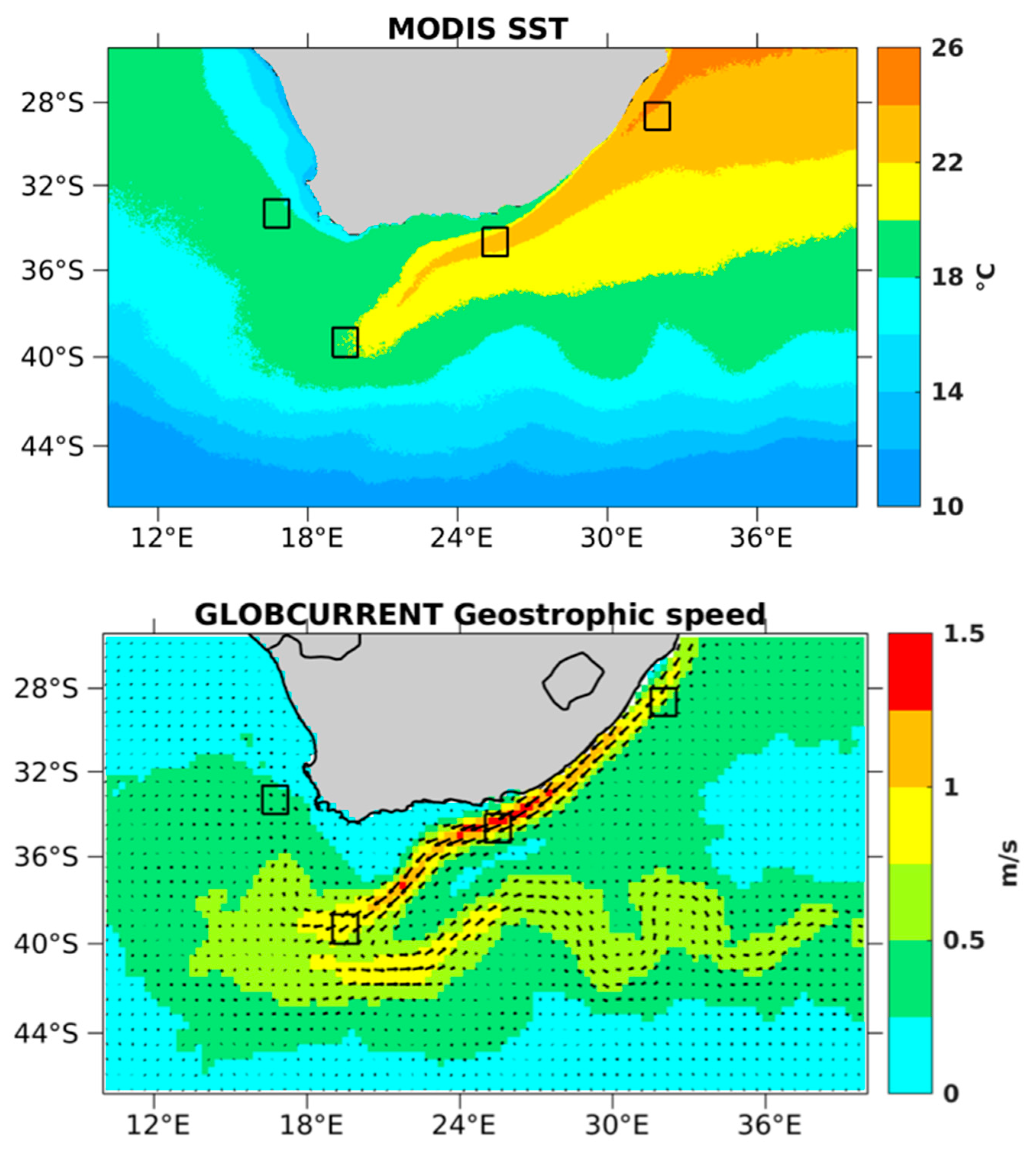
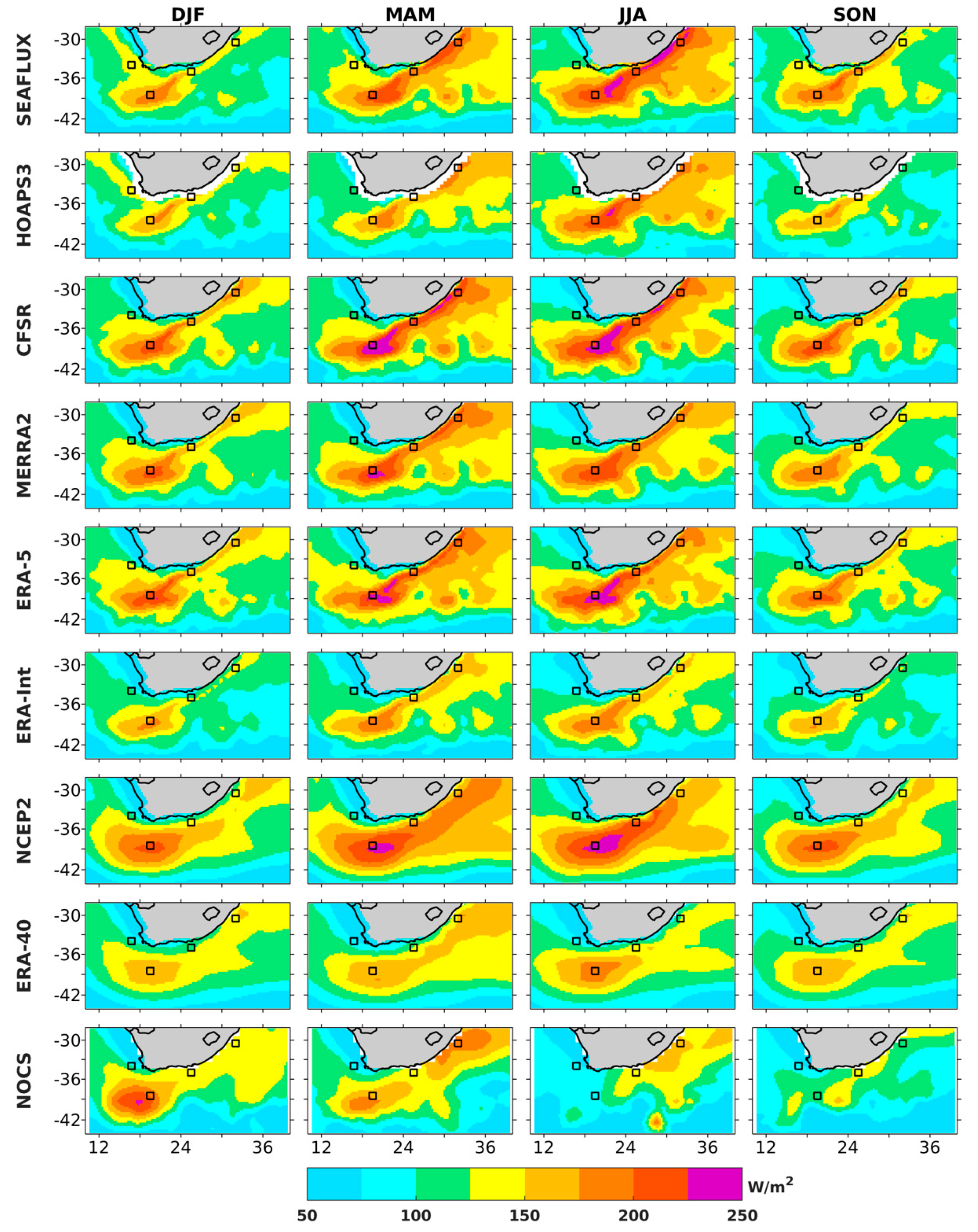
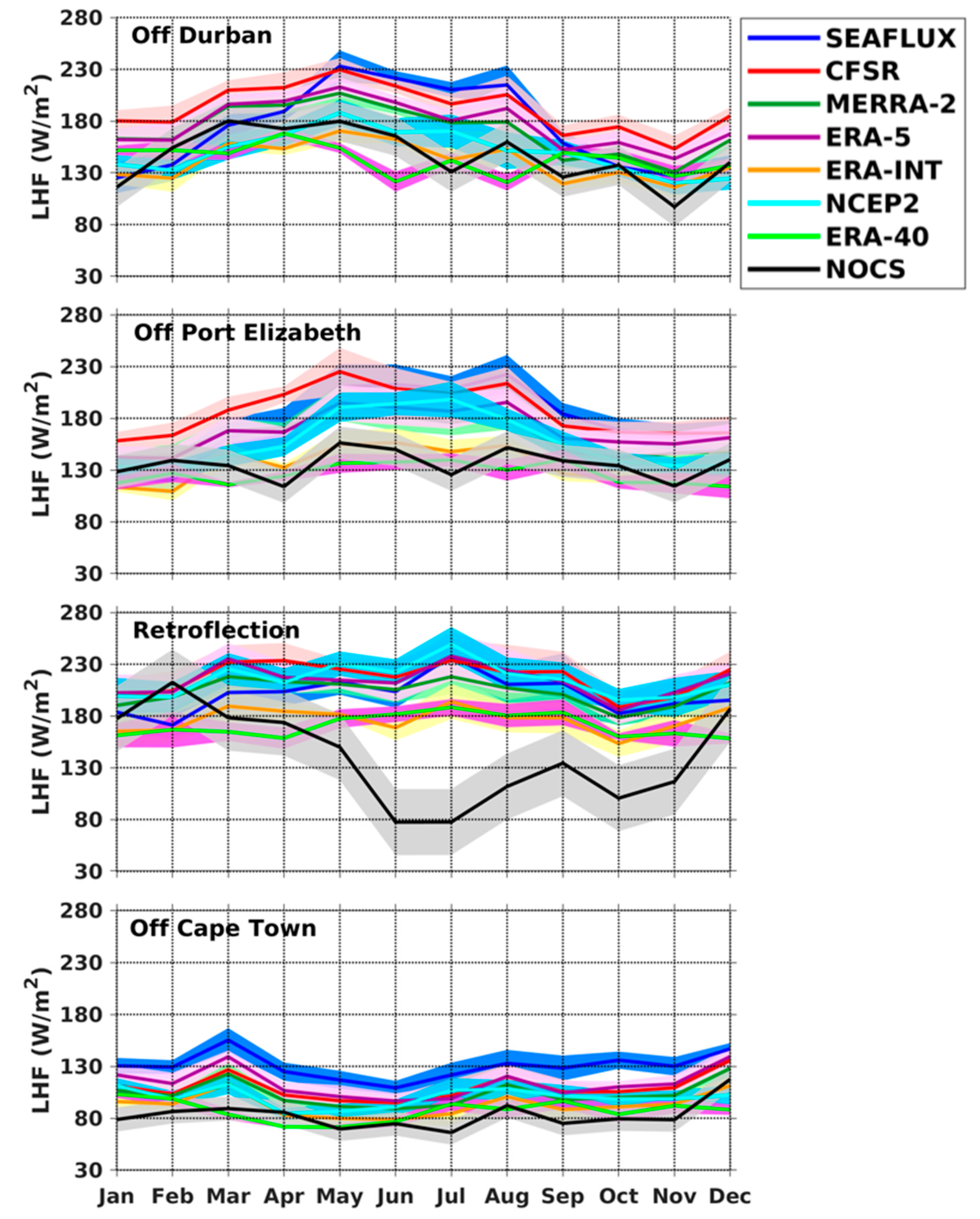
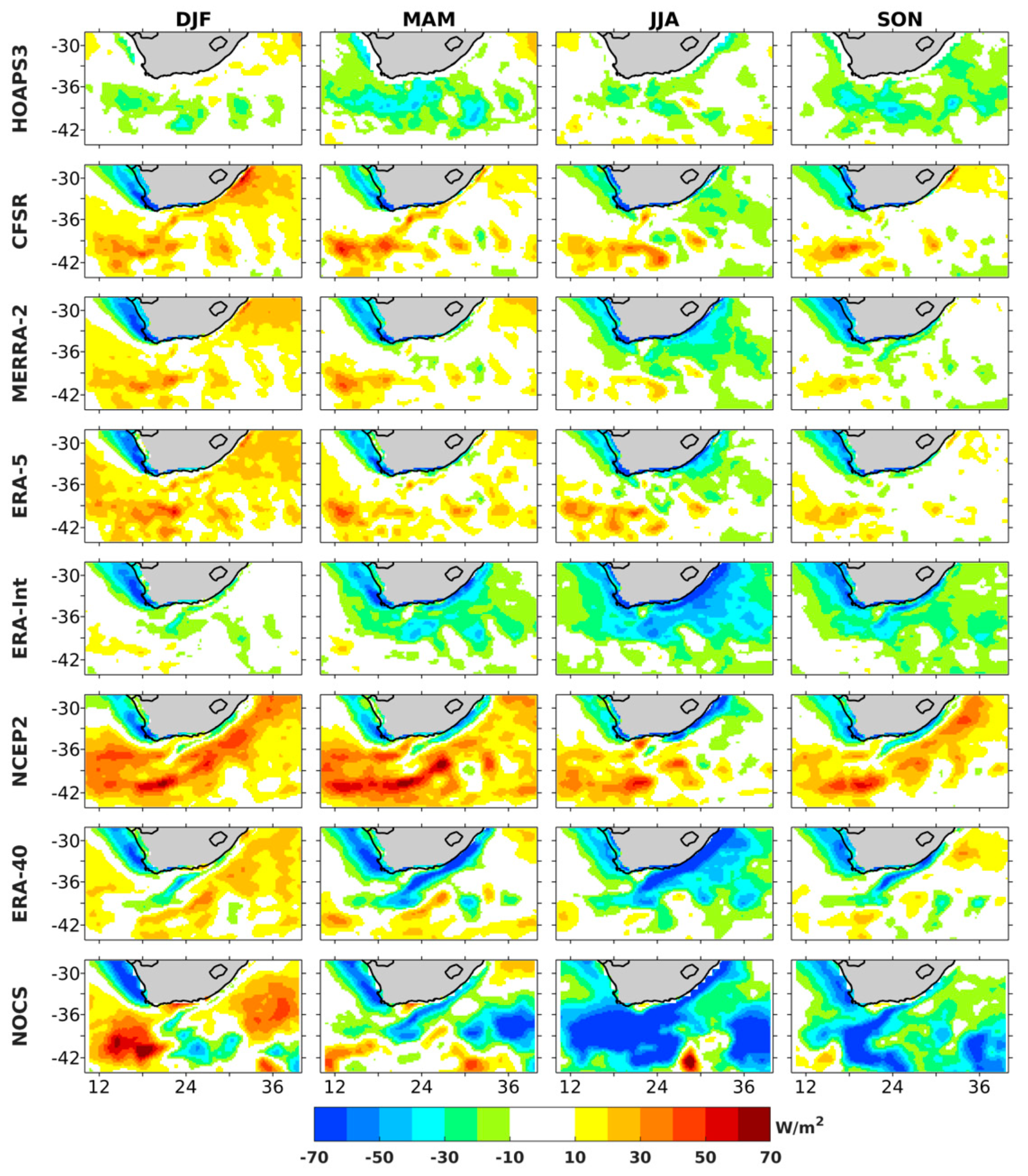

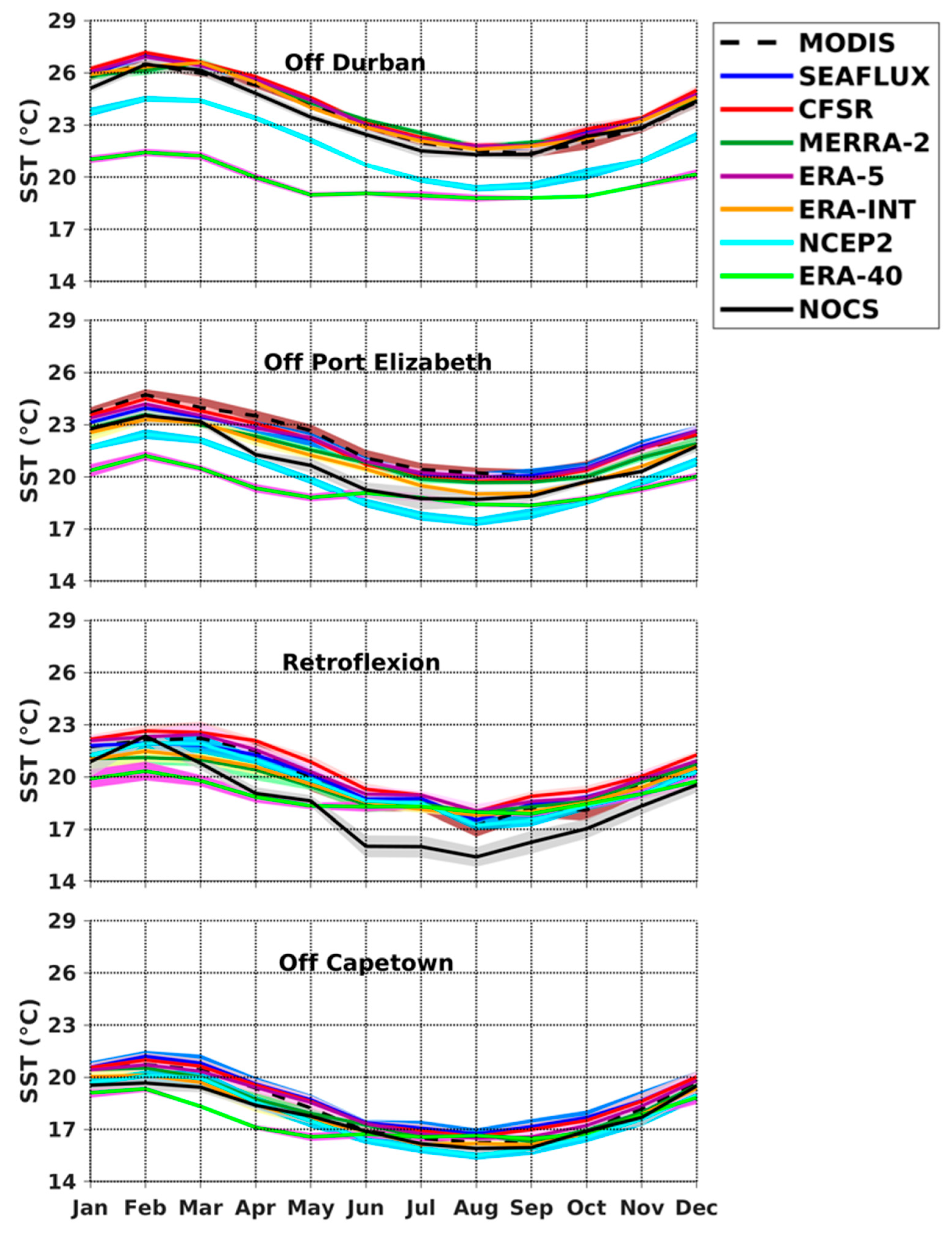
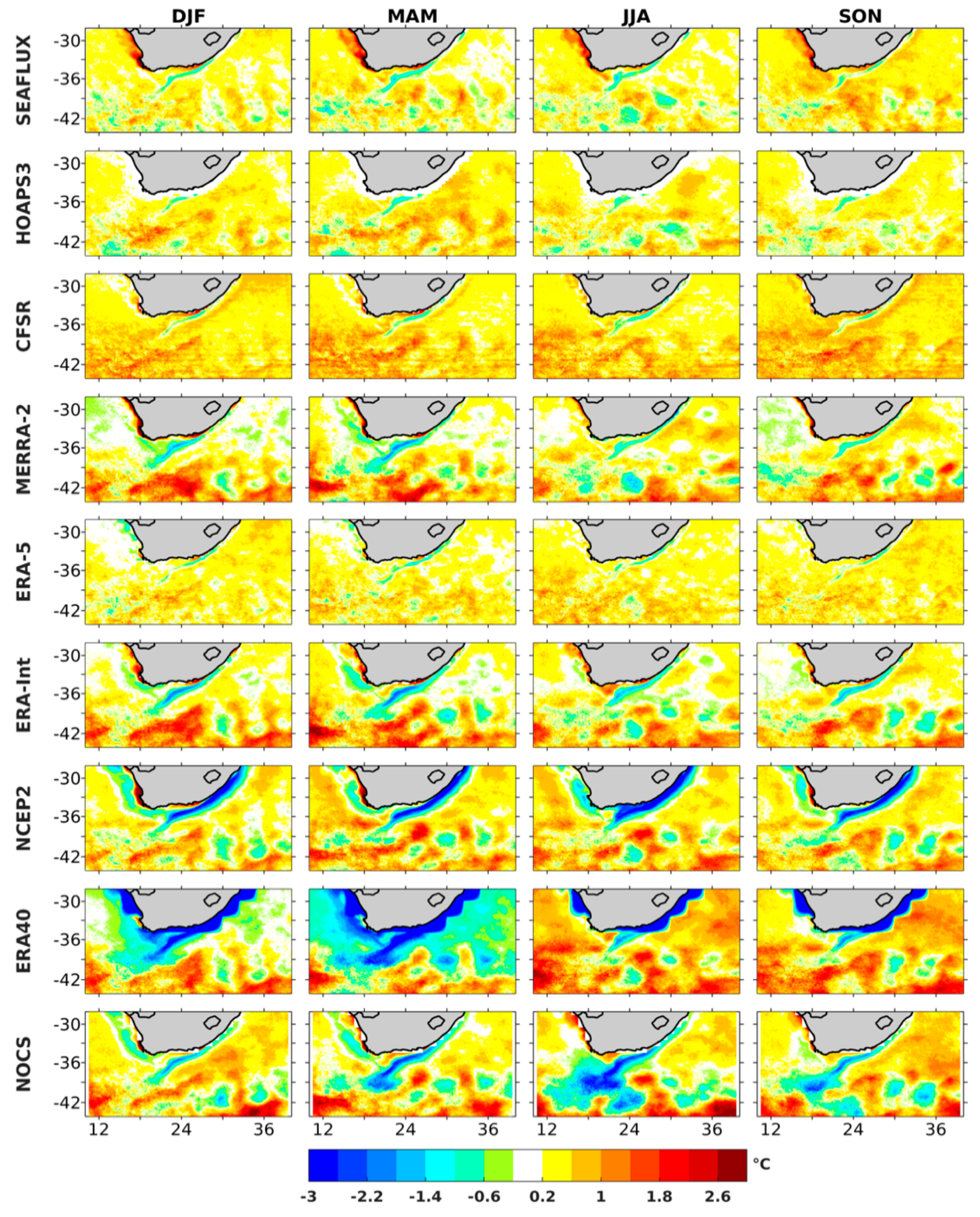
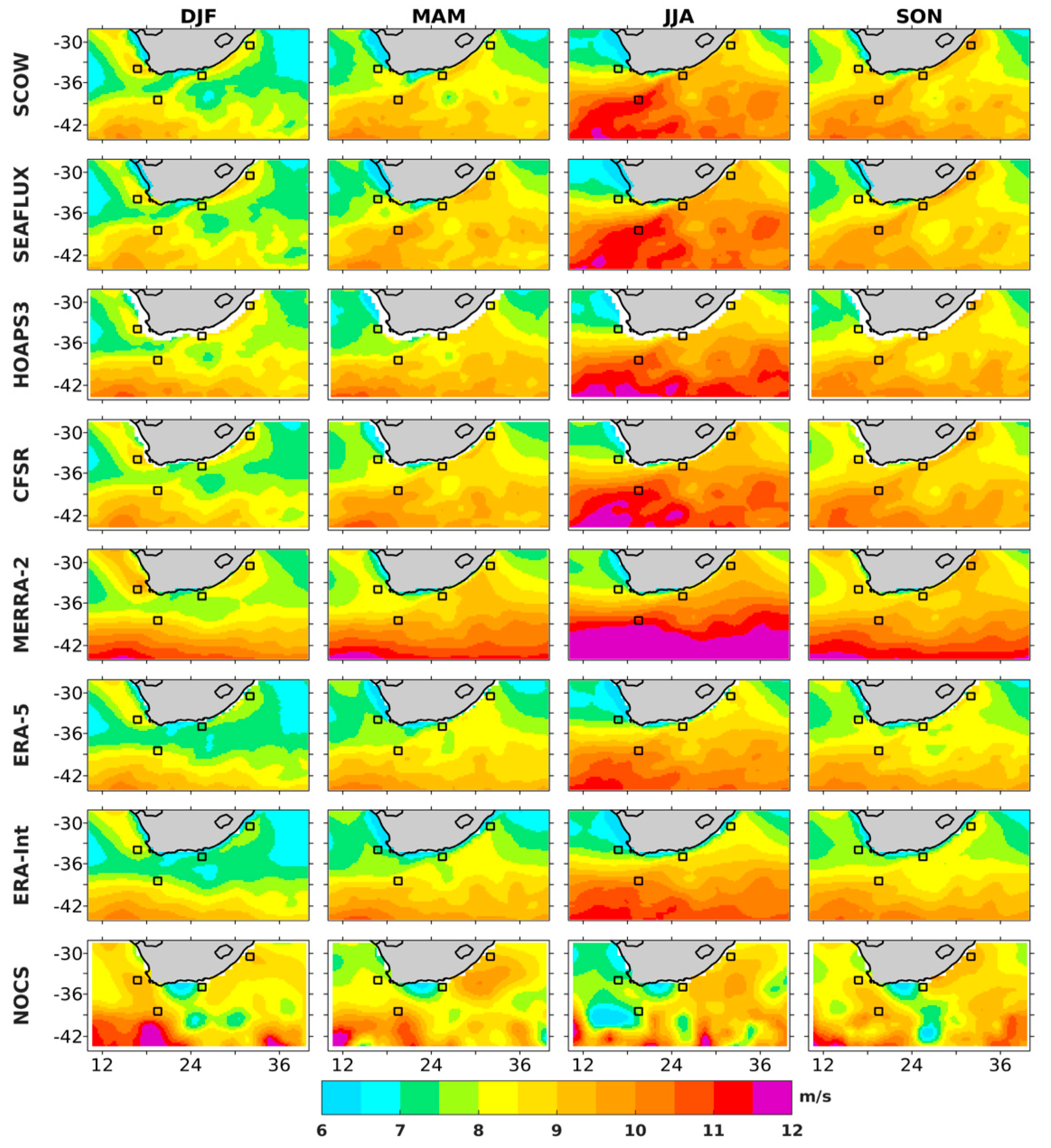
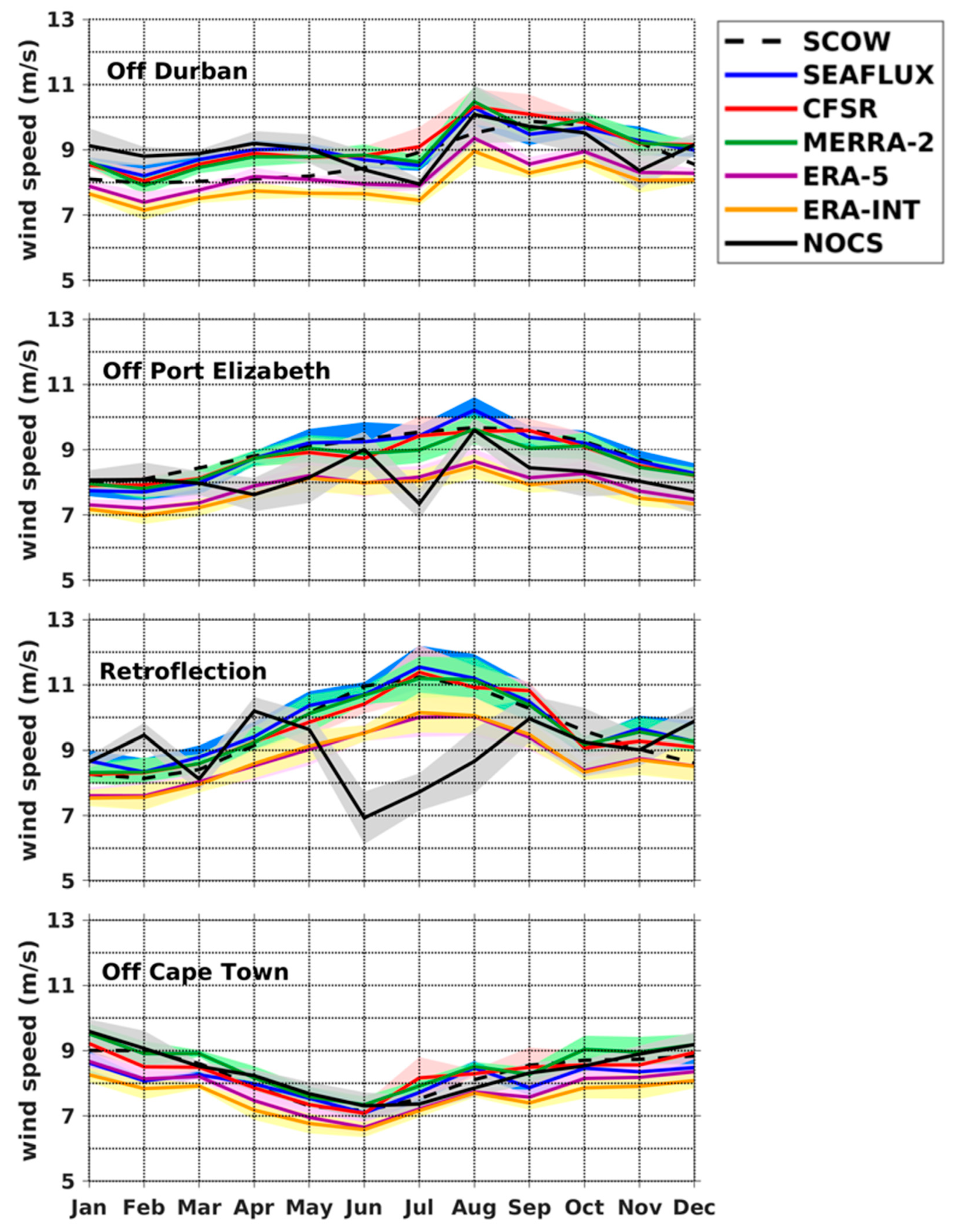
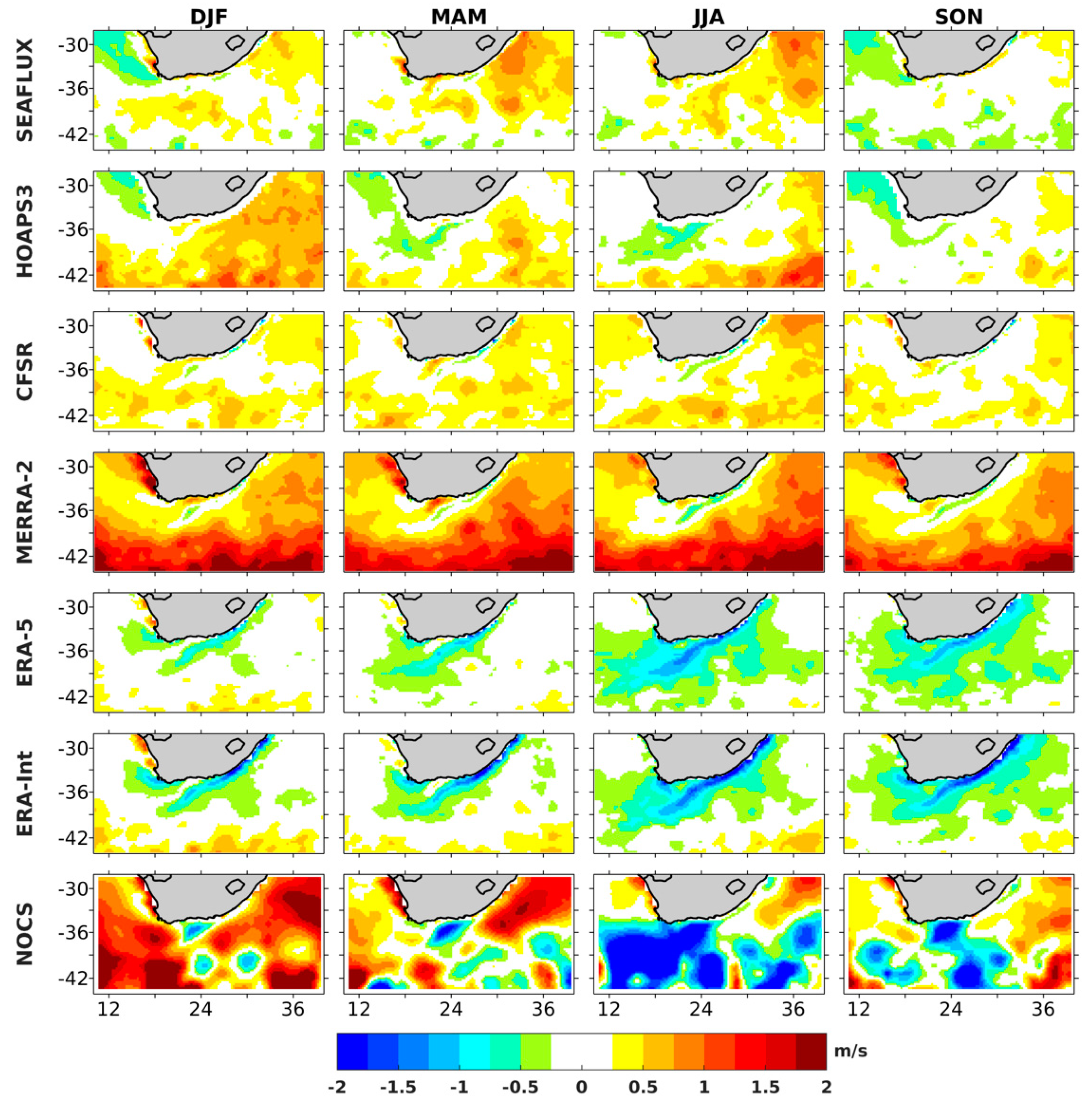
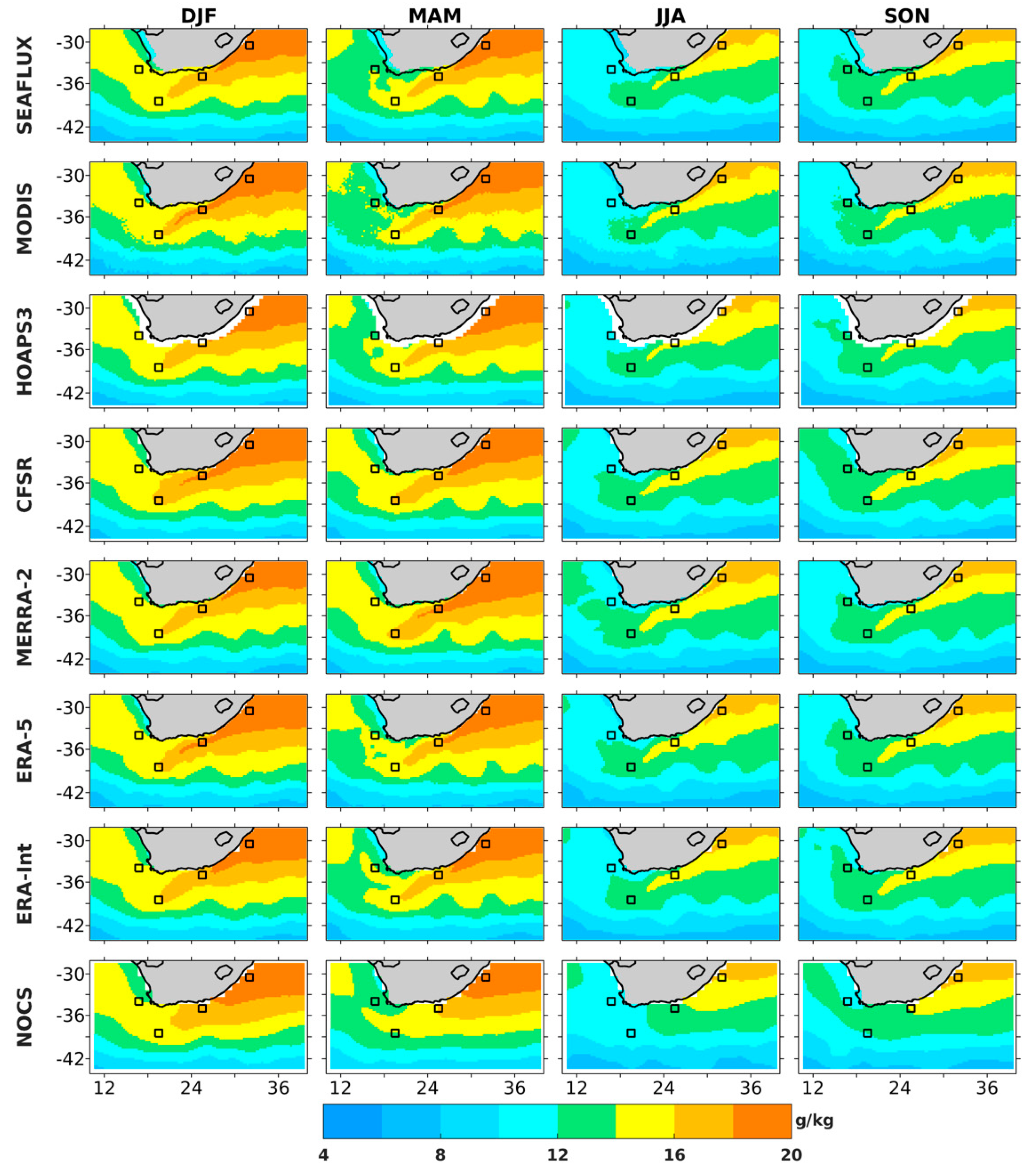
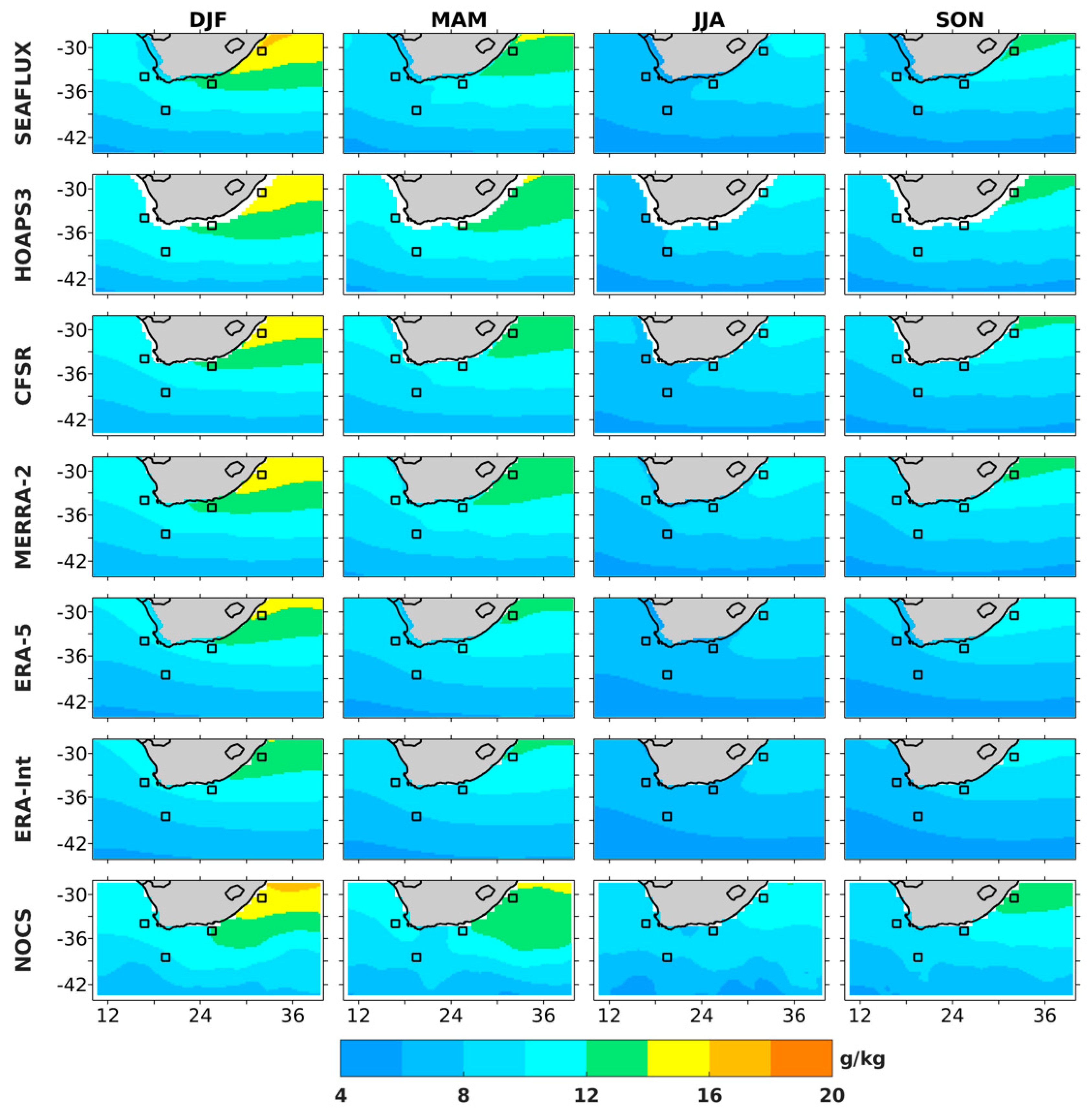
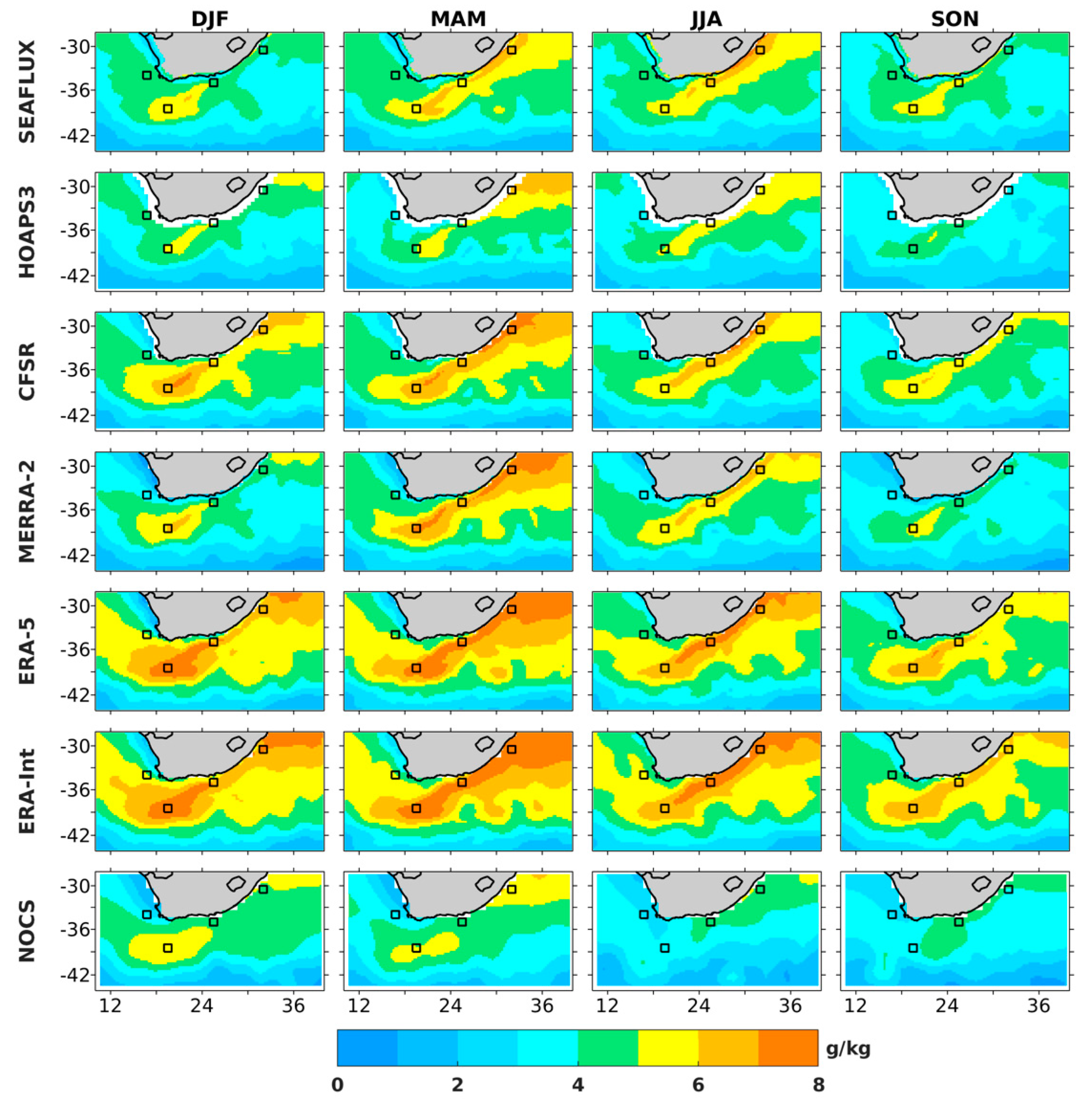
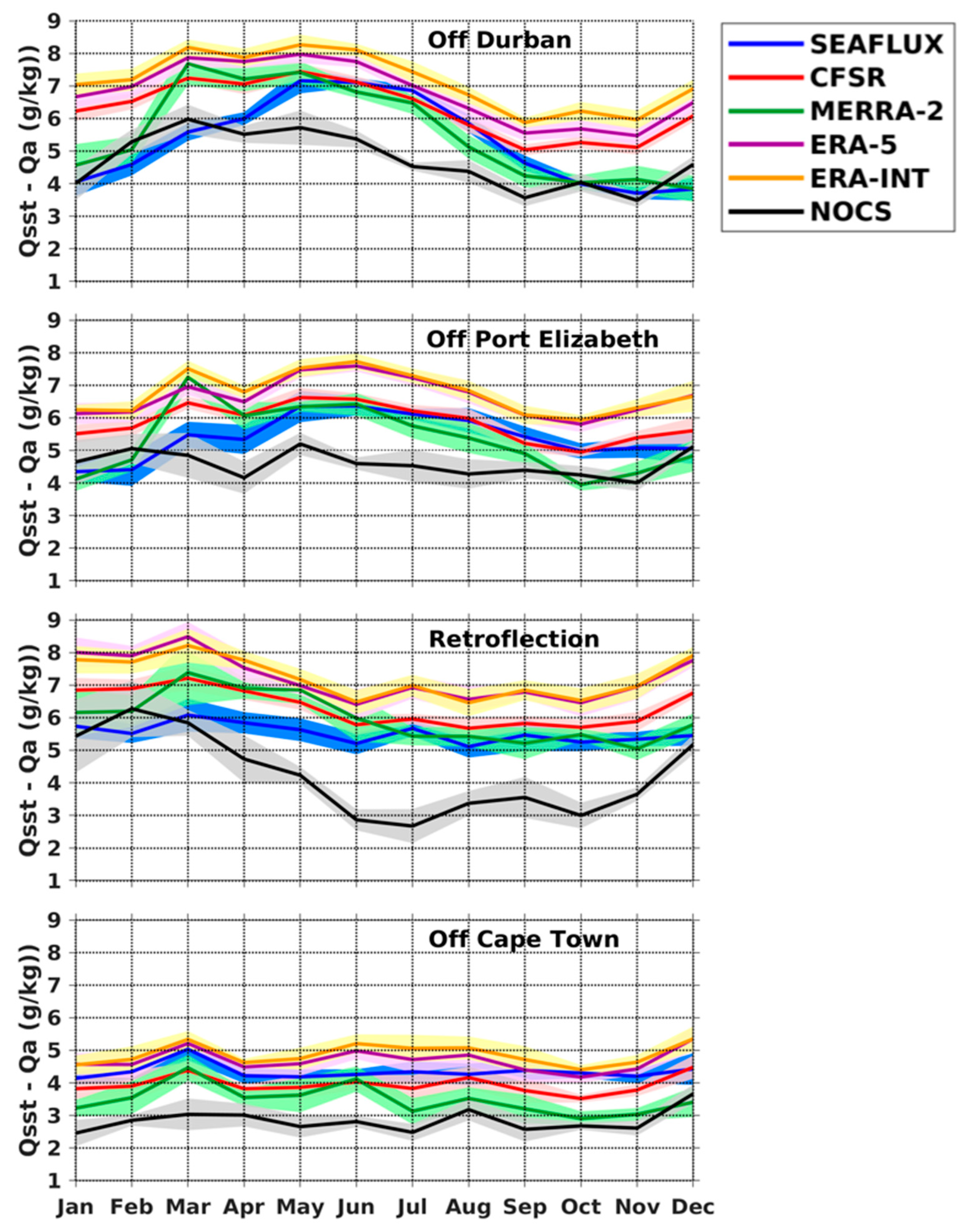

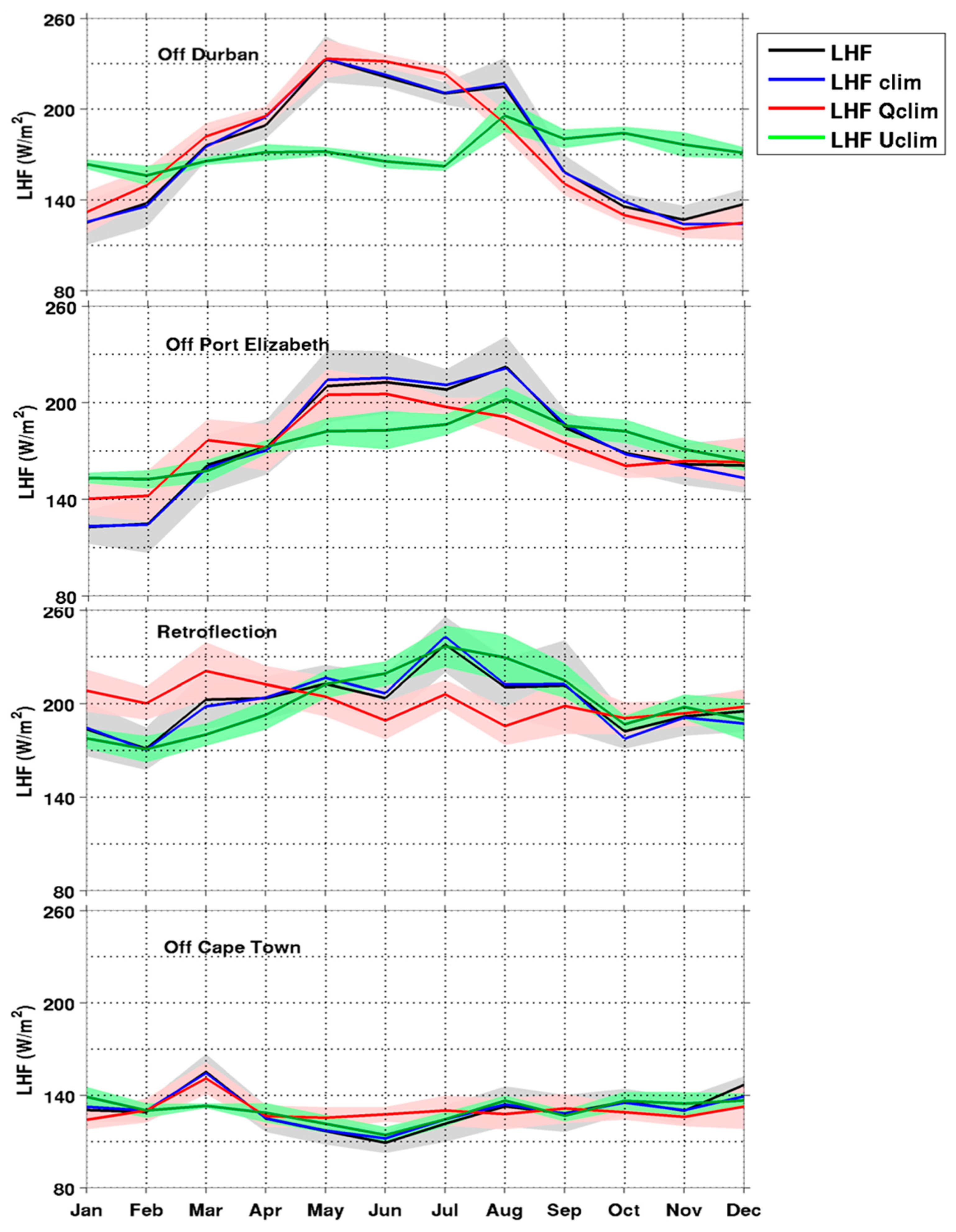
| Type | Satellite | Reanalysis | In-situ Observation | |||||||||
|---|---|---|---|---|---|---|---|---|---|---|---|---|
| Product | MODIS | GlobCurrent | SCOW | SEAFLUX | HOAPS3 | CFSR | MERRA-2 | ERA-5 | ERA-Interim | NCEP2 | ERA-40 | NOCS |
| Resolution | 0.04° × 0.04° | 0.25° × 0.25° | 0.25° × 0.25° | 0.25° × 0.25° | 0.5° × 0.5° | 0.31° × 0.31° | 0.50° × 0.66° | 0.25° × 0.25° | 0.75° × 0.75° | 1.90° × 1.87° | 2.5° × 2.5° | 1° × 1° |
| Averaging period | 2003 2007 | 2003 2007 | 1999 2007 | 2003 2007 | 2003 2005 | 2003 2007 | 2003 2007 | 2003 2007 | 2003 2007 | 2003 2007 | 1997 2001 | 2003 2006 |
| SST | X | X | X | X | X | X | X | X | X | X | ||
| Geostrophic current | X | |||||||||||
| Wind speed | X | X | X | X | X | X | X | X | ||||
| latent heat flux | X | X | X | X | X | X | X | X | X | |||
| Saturated specific humidity (Qss) | X | X | X | X | X | X | X | X | ||||
| Specific humidity of air (Qa) | X | X | X | X | X | X | X | |||||
| ZONES | SEAFLUX | CFSR | MERRA-2 | ERA-INTERIM | ERA-5 | NCEP2 | ERA-40 | NOCS |
|---|---|---|---|---|---|---|---|---|
| Off Durban | 172.1 | 192.0 | 171.1 | 141.2 | 177.1 | 150.0 | 143.0 | 146.6 |
| Off Port Elizabeth | 175.9 | 186.2 | 162.1 | 134.4 | 168.3 | 156.9 | 126.5 | 135.6 |
| Retroflection | 200.5 | 216.9 | 203.4 | 176.5 | 214.0 | 214.8 | 170.3 | 141.4 |
| Mean Agulhas | 182.8 | 198.4 | 178.9 | 150.7 | 186.5 | 173.9 | 146.6 | 141.2 |
| Off Cape town | 130.1 | 109.4 | 103.5 | 92.1 | 141.2 | 100.0 | 87.3 | 82.8 |
| ZONES | MODIS | SEA FLUX | CFSR | MERRA-2 | ERA-5 | ERA-INTERIM | NCEP2 | ERA-40 | NOCS |
|---|---|---|---|---|---|---|---|---|---|
| Off Durban | 23.7 | 24.1 | 24.2 | 24.0 | 24.1 | 23.8 | 21.7 | 19.7 | 23.5 |
| Off Port Elizabeth | 22.1 | 21.8 | 21.8 | 21.4 | 21.8 | 21.5 | 19.8 | 19.4 | 20.7 |
| Retroflection | 19.9 | 20.0 | 20.5 | 19.5 | 20.2 | 20.1 | 19.6 | 19.4 | 18.4 |
| Mean Agulhas | 21.9 | 22.0 | 22.2 | 21.6 | 22.0 | 21.8 | 20.4 | 19.5 | 20.9 |
| Off Cape town | 18.3 | 18.8 | 18.7 | 18.2 | 18.5 | 18.5 | 17.7 | 17.5 | 17.8 |
| ZONES | SCOW | SEAFLUX | CFSR | MERRA-2 | ERA-5 | ERA-INTERIM | NOCS |
|---|---|---|---|---|---|---|---|
| Off Durban | 8.7 | 9.0 | 9.1 | 9.0 | 8.2 | 7.9 | 9.0 |
| Off Port Elizabeth | 8.9 | 8.8 | 8.7 | 8.7 | 7.9 | 7.7 | 8.2 |
| Retroflection | 9.6 | 9.8 | 9.6 | 9.7 | 8.8 | 8.8 | 8.9 |
| Mean Agulhas | 9.1 | 9.2 | 9.1 | 9.1 | 8.3 | 8.1 | 8.7 |
| Off Cape Town | 8.3 | 8.1 | 8.3 | 8.5 | 7.8 | 7.6 | 8.4 |
| ZONES | SEAFLUX | CFSR | MERRA-2 | ERA-5 | ERA-INTERIM | NOCS |
|---|---|---|---|---|---|---|
| Off Durban | 5.3 | 6.3 | 5.5 | 6.8 | 7.2 | 4.7 |
| Off Port Elizabeth | 5.4 | 5.9 | 5.3 | 6.6 | 6.7 | 4.6 |
| Retroflection | 5.5 | 6.3 | 6.0 | 7.2 | 7.2 | 4.2 |
| Mean Agulhas | 5.4 | 6.2 | 5.6 | 6.9 | 7.0 | 4.5 |
| Off Cape town | 4.3 | 3.9 | 3.5 | 4.7 | 4.9 | 2.8 |
| LHF Recalculated | Correlation | Ratio (%) | Explained variance (%) |
|---|---|---|---|
| Off Durban | |||
| LHF_clim | 0.99 | 110 | 99 |
| LHF_Qclim | 0.96 | 112 | 48 |
| LHF_Uclim | 0.10 | 7 | 1 |
| Off Port Elizabeth | |||
| LHF_clim | 0.99 | 109 | 99 |
| LHF_Qclim | 0.94 | 45 | 31 |
| LHF_Uclim | 0.90 | 22 | 21 |
| Retroflection | |||
| LHFclim | 0.99 | 129 | 95 |
| LHF_Qclim | 0.13 | 34 | 2 |
| LHF_Uclim | 0.85 | 149 | 45 |
| Off Cape Town | |||
| LHFclim | 0.98 | 77 | 95 |
| LHF_Qclim | 0.71 | 32 | 20 |
| LHF_Uclim | 0.75 | 36 | 22 |
© 2019 by the authors. Licensee MDPI, Basel, Switzerland. This article is an open access article distributed under the terms and conditions of the Creative Commons Attribution (CC BY) license (http://creativecommons.org/licenses/by/4.0/).
Share and Cite
Imbol Nkwinkwa N., A.S.; Rouault, M.; Johannessen, J.A. Latent Heat Flux in the Agulhas Current. Remote Sens. 2019, 11, 1576. https://doi.org/10.3390/rs11131576
Imbol Nkwinkwa N. AS, Rouault M, Johannessen JA. Latent Heat Flux in the Agulhas Current. Remote Sensing. 2019; 11(13):1576. https://doi.org/10.3390/rs11131576
Chicago/Turabian StyleImbol Nkwinkwa N., Arielle Stela, Mathieu Rouault, and Johnny A. Johannessen. 2019. "Latent Heat Flux in the Agulhas Current" Remote Sensing 11, no. 13: 1576. https://doi.org/10.3390/rs11131576
APA StyleImbol Nkwinkwa N., A. S., Rouault, M., & Johannessen, J. A. (2019). Latent Heat Flux in the Agulhas Current. Remote Sensing, 11(13), 1576. https://doi.org/10.3390/rs11131576




